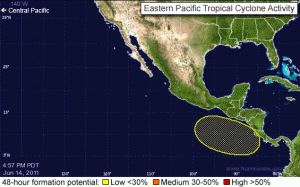 by Mark Morelli of Ocean Camp San Carlos
by Mark Morelli of Ocean Camp San Carlos
It’s that time of year again. For those of us who make San Carlos our fulltime home we know already the joys and not-so-joyous news about summer and fall months. Hurricane and Tropical Storm season is here and we have a now-dissipated former hurricane that still may affect us along the Sonora coast. Nothing major, but it should serve as a wake-up call to dust-off your family and neighborhood preparedness plan. You have one, right?
The first storm of this season was fast-developing Hurricane Adrain. The National Hurricane Center (in the USA) sent its first advisory about Adrain on June 7th., which was then a Tropical Depression. It bloomed quickly in a major hurricane on the morning of June 9th. Computer model forecasts where behind “real-time” events of the fast developing storm, but most agreed that it would travel Westbound and not encounter Mexican land mass. The next morning it was a category 4 storm with sustained winds of 140 MPH and 40-foot seas. Computer models from around the globe were tracking and forecasting its next moves, and they were devided. One group called for a contended Westward movement and fast dissipation over the cooler seas; the other group predicted it would swing North or Northeast and that would put it on a path to Baja and the West Coast of Mexico. As of today (Saturday, June 11th) it seems the “Westward” group won, but don’t count this storm out yet. It may still turn Northeastward and bring rain and wind next week (June 13-15) and heavy surf starting over this weekend (June 11-12).
Keep an eye on the weather at our San Carlos Weather page.
Hurricane and Tropical Storm Preparedness:
Hurricane hazards come in many forms: storm surge, high winds, tornadoes, and flooding. This means it is important for your family to have a plan that includes all of these hazards. Look carefully at the safety actions associated with each type of hurricane hazard and prepare your family disaster plan accordingly. But remember this is only a guide. The first and most important thing anyone should do when facing a hurricane threat is to use common sense.
Family Disaster Plan:
- Discuss the type of hazards that could affect your family. Know your home’s vulnerability to storm surge, flooding and wind.
- Locate a safe room or the safest areas in your home for each hurricane hazard. In certain circumstances the safest areas may not be your home but within your community.
- Determine escape routes from your home and places to meet. These should be measured in tens of miles rather than hundreds of miles.
- Have an out-of-state friend as a family contact, so all your family members have a single point of contact.
- Make a plan now for what to do with your pets if you need to evacuate.
- Post emergency telephone numbers by your phones and make sure your children know how and when to call 911.
- Check your insurance coverage – flood damage is not usually covered by homeowners insurance.
- Stock non-perishable emergency supplies and a Disaster Supply Kit.
- Use a NOAA weather radio. Remember to replace its battery every 6 months, as you do with your smoke detectors.
- Take First Aid, CPR and disaster preparedness classes.
Disaster Supply Kit
Home Emergency Planning — GOOD ALL YEAR LONG.
- Water – at least 1 gallon daily per person for 3 to 7 days
- Food – at least enough for 3 to 7 days— non-perishable packaged or canned food / juices— foods for infants or the elderly— snack foods— non-electric can opener— cooking tools / fuel— paper plates / plastic utensils
- Blankets / Pillows, etc.
- Clothing – seasonal / rain gear/ sturdy shoes
- First Aid Kit / Medicines / Prescription Drugs
- Special Items – for babies and the elderly
- Toiletries / Hygiene items / Moisture wipes
- Flashlight / Batteries
- Radio – Battery operated
- Telephones – Fully charged cell phone with extra battery and a traditional (not cordless) telephone set
- Cash (with some small bills) and Credit Cards – Banks and ATMs may not be available for extended periods
- Keys
- Toys, Books and Games
- Important documents – in a waterproof container or watertight resealable plastic bag— insurance, medical records, bank account numbers, Social Security card, etc.
- Tools – keep a set with you during the storm
- Vehicle fuel tanks filled
- Pet care items— proper identification / immunization records / medications— ample supply of food and water— a carrier or cage— muzzle and leash
Other Hurricane tested devices, see: Hurricane Tested shower commode chair














